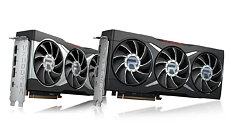
Intel Readies Third DG2 "Alchemist" ASIC with 256 EU
Intel's recently announced Arc "Alchemist" line of discrete gaming graphics processors consists of at least five mobile SKUs across the Arc 3, Arc 5, and Arc 7 lines; with desktop SKUs expected later this year. These are based on one of two ASICs—the DG2-128 (ACM-G11) and the DG2-512 (ACM-G10), both built on the TSMC N6 (6 nm) silicon fabrication process. Coelacanth's Dream discovered a third ASIC when digging through Intel Graphics Compiler code on GitHub, referred to as the "ACM-G12."
This silicon has exactly half the amount of number-crunching machinery as the DG2-512, and features 256 execution units (EU), or 16 Xe cores, working out to 2,048 unified shaders—double that of the DG2-128, but half that of the DG2-512. Interestingly, the Arc 5 A550M mobile GPU announced last week has specifications corresponding to this silicon, even though it was announced to be a heavily cut-down DG2-512. Intel probably figures that at some point making A550M GPUs using DG2-512 could mean cutting down perfectly functional silicon, and so it makes sense to manufacture physically smaller dies (more dies per wafer). There are no other known specs of the ACM-G12. It's quite likely given the rest of its alignment with the A550M's specs that it could feature a 128-bit wide GDDR6 memory interface.
This silicon has exactly half the amount of number-crunching machinery as the DG2-512, and features 256 execution units (EU), or 16 Xe cores, working out to 2,048 unified shaders—double that of the DG2-128, but half that of the DG2-512. Interestingly, the Arc 5 A550M mobile GPU announced last week has specifications corresponding to this silicon, even though it was announced to be a heavily cut-down DG2-512. Intel probably figures that at some point making A550M GPUs using DG2-512 could mean cutting down perfectly functional silicon, and so it makes sense to manufacture physically smaller dies (more dies per wafer). There are no other known specs of the ACM-G12. It's quite likely given the rest of its alignment with the A550M's specs that it could feature a 128-bit wide GDDR6 memory interface.














































